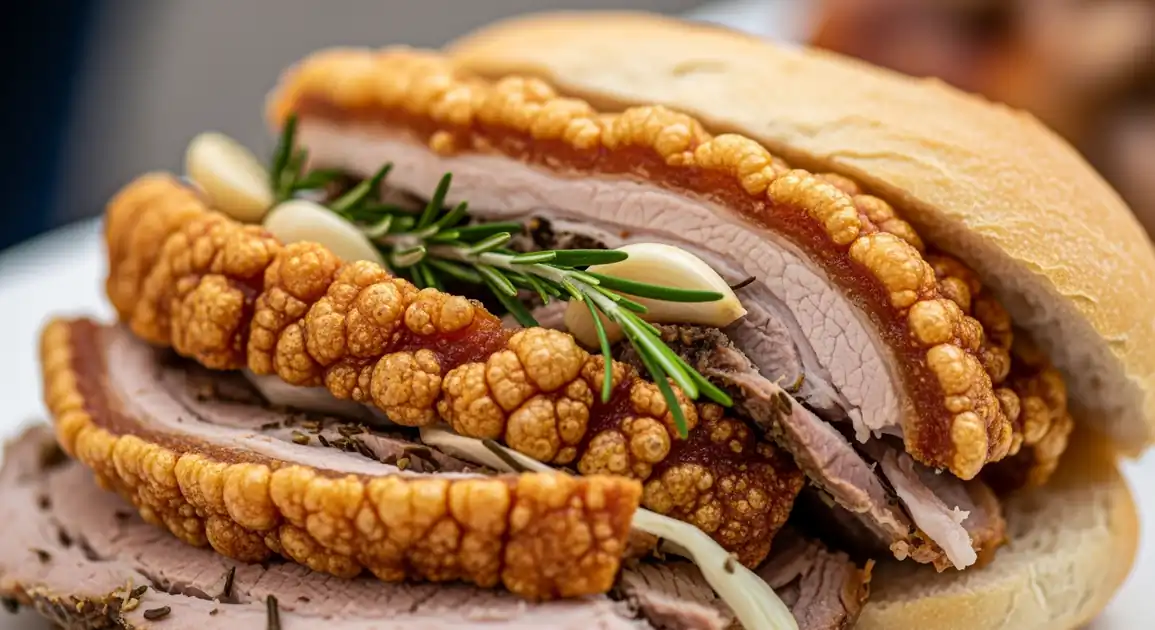Porchetta
Porchetta

Description
Rome and its surrounding Castelli Romani region (especially Ariccia) are arguably the spiritual home of modern porchetta appreciation. You'll find numerous excellent vendors operating from white trucks ('furgoni') and stalls, particularly at markets and just outside the city center. The Roman style often emphasizes wild fennel, garlic, salt, and pepper.
Dietary Information
Serving information
Serving style
Predominantly served as 'panino con la porchetta'. Sliced meat by weight is also available at market stalls and norcinerie.
Quick facts
Vendors usually operate from mid-morning (10-11 AM) until mid-afternoon (3-4 PM) or until sold out.
Safety Tips
What to Look For
-
Vendor slices meat fresh from the whole roast
Ensures freshness and avoids risks associated with pre-sliced meat sitting out.
-
Meat appears moist and skin looks crispy
Visual cues for quality and proper cooking/holding. Avoid porchetta that looks dry or has soggy skin.
-
Clean vendor setup (truck/stall, knives, board)
Good hygiene practices are essential for food safety.
-
High customer turnover
Indicates the porchetta is fresh and popular, reducing the time it sits around.
-
Porchetta kept warm (if applicable)
While often served room temp shortly after slicing, if it's meant to be hot, ensure it's held properly.
What to avoid
-
Pre-sliced porchetta sitting out for long periods
Increases risk of bacterial growth and loss of quality (dry meat, soggy skin).
-
Meat looks visibly dry, grey, or discolored
Suggests poor quality, overcooking, or being old.
-
Soggy, pale, or leathery skin
Indicates improper roasting or storage.
-
Dirty vendor area, knife, or cutting board
High risk of cross-contamination.
-
Unpleasant or 'off' smell
Indicates spoilage; do not consume.
Price information
Price range
Budget tips
- Look for vendors slightly outside the main historical center for potentially better prices.
- Markets like Testaccio or Campo de' Fiori (on market days) are good spots.
- A panino is a very filling and cost-effective meal.
Value indicators
- Vendor specializes *only* in porchetta (a good sign).
- Associated with Ariccia (often advertised).
- Long queue of locals.
- Perfectly crispy, golden skin visible on the whole roast.
- Generous slicing, fresh into a crusty 'rosetta' or 'ciriola' bun.
Where to Find This Dish
Castelli Romani (esp. Ariccia)
Worth a day trip from Rome to experience porchetta at its source. Numerous vendors in Ariccia town.
Ariccia town center, Fraschette (traditional taverns)
Lunch, Weekends
Markets (e.g., Testaccio, Campo de' Fiori)
Look for dedicated porchetta stalls within or around these famous markets.
Nuovo Mercato di Testaccio, Campo de' Fiori market area
Market hours (Morning to early afternoon)
Street Corners / Neighborhoods
Famous vendors often have semi-permanent spots known to locals (e.g., near Piramide, Trastevere station area).
Requires local knowledge or research (e.g., 'Er Buchetto', 'I Supplì' sometimes has it)
Lunchtime
Trastevere / Testaccio
These neighborhoods known for food often have good porchetta options.
Local streets, Near markets
Lunch
Vendor Tips
- Seek out vendors specifically advertising 'Porchetta di Ariccia IGP'.
- Ask for 'un panino' and let the vendor slice it fresh.
- Be prepared to eat standing up or find a nearby bench/piazza.
- Learn basic Italian numbers for price and weight ('cento grammi' = 100g).
How to Order
Regional Variations
-
Ariccia Style Dominance
(Stile di Ariccia Predominante)
The Ariccia standard (often rosemary, garlic, pepper) heavily influences Roman porchetta.
-
Bread Types
(Tipi di Pane)
Served in various local bread rolls like 'rosetta', 'ciriola', or sometimes 'pizza bianca'.
Cultural context
History
Porchetta boasts ancient origins, potentially dating back to Etruscan or Roman times in Central Italy. Its modern form is strongly associated with regions like Lazio (particularly the town of Ariccia, which holds IGP status for its specific recipe), Umbria, Tuscany, and Abruzzo. Historically a festive dish prepared for celebrations and holidays, porchetta became popular street food sold from mobile vans and market stalls, especially in the post-war era, providing affordable, flavorful sustenance. Today, it remains a beloved staple across Italy, with regional variations in seasoning.
Local significance
Deeply embedded in Roman street food culture. A source of local pride, especially the Ariccia connection.
Eating customs
- Eating the panino quickly while it's hot/fresh.
- Often washed down with local Castelli Romani white wine (Frascati) or beer.
- Focus is on the quality of the pork and the crispy skin.